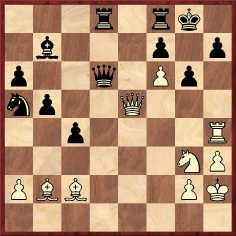
Edward Winter
(2012, with updates)
Exercise 344 on page 92 of Your Move! by Y. Neishtadt (London, 1990) is the following position:

White to move
The solution (see pages 143-145) was introduced as follows: ‘White in this game was Anderssen, who had given his pupil Zukertort a rook (Breslau 1862).’ Neishtadt recorded that Anderssen managed to draw by 1 Qg5 Qd2 2 Nf5 Qxg5 3 Ne7+ Kh8 4 Nxg6+ Qxg6 5 Bxg6 Rd2 6 Rxh7+ Kg8 7 Rg7+ and he added:
‘For more than a century Anderssen’s combination was regarded as the only way to avoid defeat. But recently the Soviet player M. Kim discovered that Anderssen could have won by beginning the combination with a bishop sacrifice: 1 Bxg6!!’
The book then provided analysis to show that Black’s four possible replies (1...hxg6, ...fxg6, ...Qxe5 and ...h6) all lost.
Neishtadt did not specify where M. Kim published his analysis, but it should be noted that the move 1 Bxg6 was pointed out by Alekhine in the 1930s. As mentioned in C.N. 4353, the above position was published on page 154 of Les Cahiers de l’Echiquier Français, September-October 1933, where readers were asked whether White, with a strong attack on the castled king but a material deficit, could win. The magazine returned to the subject on pages 215-221 of the January-February 1934 issue, where the game was firstly mentioned as an encounter at rook odds between Anderssen and Zukertort in Breslau in February 1862, the source being Ludwig Bachmann’s monograph on Anderssen (see page 177 of the second, 1914, edition). There followed four full pages of prose discussion of the position, after which came ‘Anderssen’s solution’. This was the same drawing line as that given by Neishtadt (and Bachmann), except that the final moves in the Cahiers were a different perpetual check: 5 Bxg6 Kg8 6 Bxh7+. Then the magazine presented ‘Alekhine’s solution’ from the diagram above:
‘A few months ago the writer of these lines had the idea of showing this position to Alekhine, asking him, “What would you play in this position?”. It was during a dinner, so that the situation of the pieces was quoted from memory and the world champion had to undertake his analysis and work out his solution without seeing the board. Within a few minutes he discovered Anderssen’s combination, which is hardly surprising on the part of the holder of the [blindfold] record at Chicago, 1933. But that is not all. After a few minutes’ deep thought Alekhine proposed to us another first move and, to our wonderment, immediately set out the main variations, all of which led to victory for White.’
The main lines of Alekhine’s analysis were then given, as follows (the comments in square brackets being by us):
‘1 Bxg6!! Notwithstanding the tremendous defence of the g6-pawn by the pawns on f7 and h7. In fact, capturing the bishop is impossible.
1...Qxe5 Best. If 1...fxg6 2 f7+ Kxf7 3 Rf4+ and a quick mate. [3 Rxh7+ is faster.] If 1...hxg6 then 2 Qg5 (with the double threat of 3 Qh6 and 3 Rh8+) 2...Qd2 3 Nf5! (with the double threat of 4 Ne7 mate and 4 Nh6+ Kh8 or Kh7 5 Nxf7+ Kg8 6 Qxg6 mate) 3...Rfe8 (best) 4 Ne7+ Rxe7 5 Rh8+!! Kxh8 6 fxe7+ and wins.
2 Bxh7+ The bishop could not be captured by Black, and it opens up a wider breach, seizing the g- and h-pawns; gradually the material deficit is recovered.
2...Kh8 3 Bxe5 Threatening 4 Nf5, followed by 5 Ne7 and discovered mate by the bishop.
3...Rfe8 The only move permitting Black to prolong resistance. For example, 3...Rd2 4 Be4+ Kg8 5 Nf5, etc.
4 Bc3!! A profound move. 4 Bb2 would fail as it would not oblige Black to save his attacked knight and would allow him to place a rook on d2 for a counter-attack.
4...b4 Best. Immediately retreating the knight to c6 would be insufficient.
5 Bxb4 Nc6 Saving the knight and bringing it to watch over the e7 square, but the bishop is cut off.
6 Bc3 Threatening 7 Nf5.
6...Re3 If 6...Bc8 7 Be4+ Kg8 8 Bxc6 wins.
7 Bb2! wins. For example, 7...Rd2 8 Nf5 Re8 (if 8....Rxb2 9 Nxe3) 9 Ne7! Nxe7 10 Bc2+! Kg8 11 fxe7 and wins.’
The French magazine returned to the subject on pages 347-348 of the September-October 1934 issue, firstly correcting the note to 7 Bb2 in Alekhine’s line:
‘After 7 Bb2 Rd2, 8 Nf5? is a mistake which enables Black, with 8...Ree2 (instead of 8...Re8 or 8...Rxb2 as indicated in the note), to achieve a draw through the threat of 9...Rxg2+ and perpetual check. On the other hand, after 7 Bb2 Rd2 White simply needs to play 8 Nf1! (or 8 Bc1), winning the exchange and ensuring a won endgame. Thus, as Mr Hardouin of Saint-Lô points out to us, the validity of Alekhine’s discovery is not undermined at all, since the remedy is discovered at the same time as the disease.
Mr Defosse of Brussels does not contest the viability of Alekhine’s analysis but points out to us an interesting alternative line at White’s sixth move, a line which also seems to win quickly. After 1 Bxg6 2 Qxe5 2 Bxh7+ Kh8 3 Bxe5 Re8 4 Bc3 b4 5 Bxb4 Nc6, instead of 6 Bc3 it is also possible to win with 6 Be4+! Kg8 7 Bxc6! Bxc6 8 Nf5! The idea is to threaten 9 Ne7+, forcing 9...Rxe7, because if 9...Kf8 10 Nxc6, taking advantage of the position of the undefended black bishop at c6 and of the valuable activeness of the white bishop on the a3-f8 diagonal. [After 9 Ne7+ Kf8 White has 10 Rh8 mate.] It does indeed appear that Black is forced to give up the exchange and another pawn, leaving White with a won endgame despite the bishops of opposite colours. Here are some variations:
A) 8...Rd3 9 Rxc4 Re4 (if 9...Bb5? 10 Ne7+ Rxe7 forced 11 fxe7 wins) 10 Ne7+ Kh7 11 Rc5! (threatening 12 Rh5 mate) 11...Kh6 or Rh4 12 Nxc6 wins.
B) 8...a5 9 Bc3 (without loss of a tempo) 9...Rd3 10 Rxc4 Bd5 11 Ne7+ Kf8 forced 12 Rh4!, followed by mate.
C) 8...Rb8 9 Bc3 Bb5 10 Ne7+ Rxe7 11 fxe7 f6 12 Bxf6 wins.
D) 8...Rd7 9 Bc3, entering a familiar variation.
E) 8...Rd5 9 Ne7+ Rxe7 10 fxe7 f5 11 Rxc4 wins.
F) 8...Bb5
9 Bf8!! (the point) 9...Re4 (if 9...Kxf8 10 Rh8 mate, and if 9...Rxf8 10 Ne7 mate; if 9....Rd4 10 Nxd4 Rxf8 11 Nf5 Re8 12 Ne7+ Rxe7 13 fxe7 wins) 10 Ne7+! Rxe7 11 Bg7 and mate by 12 Rh8.
The Defosse variation is thus a dual ... with which we are delighted. Far from marring this practical problem as if it were an artistic problem, it enriches it with all its complexity.’
Below is the analysis as it appeared in the French magazine (pages 220, 221, 347 and 348), as well as the relevant page of Bachmann’s book on Anderssen:
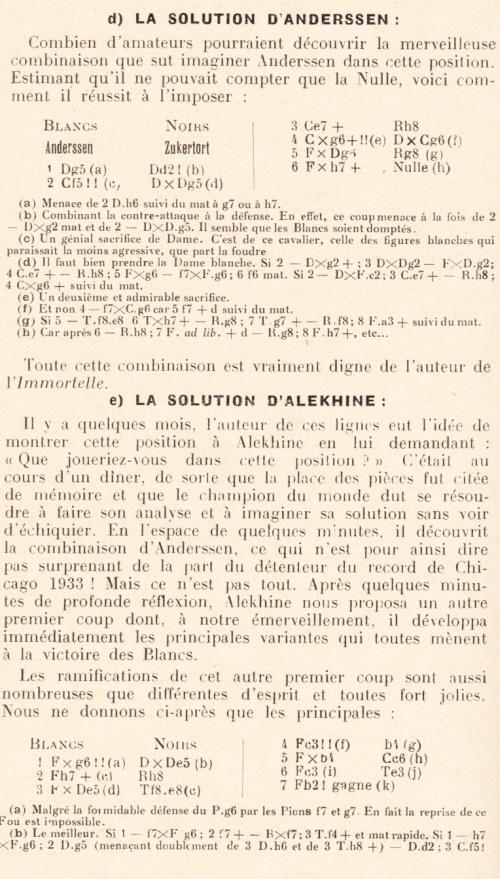
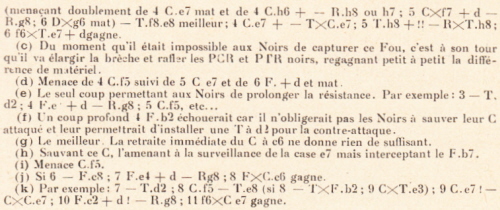
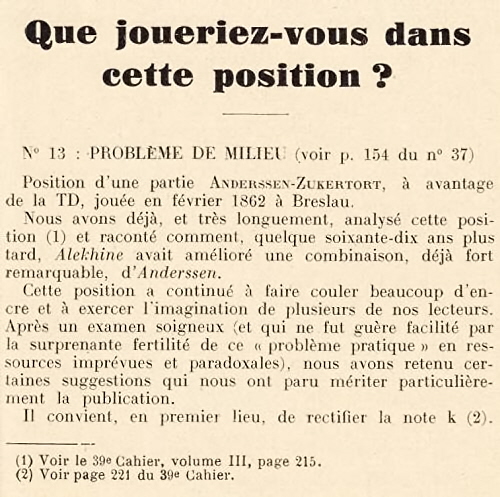
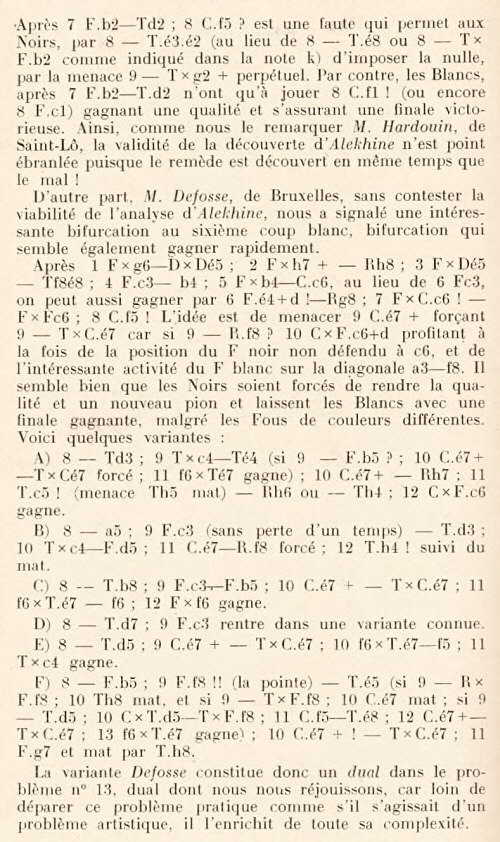
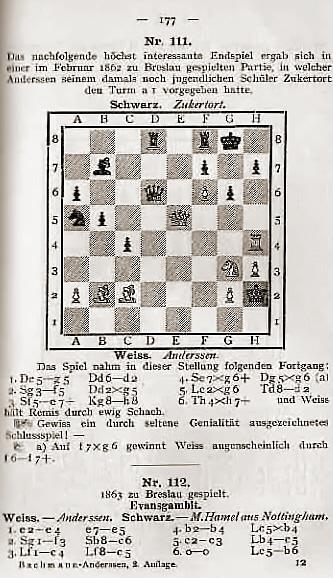
The Alekhine analysis (although not the subsequent Defosse material) was given by D.J. Morgan on page 130 of the May 1957 BCM:
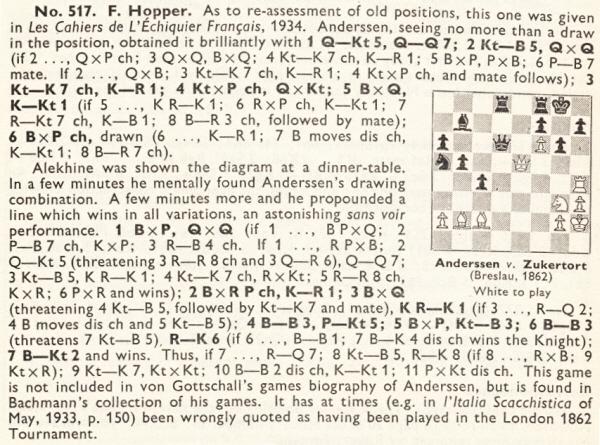
A prose account of Alekhine’s feat appeared on page 60 of Curious Chess Facts by Irving Chernev (New York, 1937):
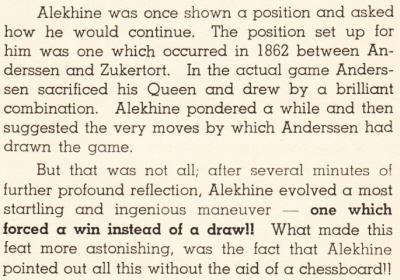
When Fred Reinfeld discussed the Anderssen v Zukertort game on pages 271-273 of The Joys of Chess (New York, 1961) he showed no knowledge of what had appeared in the French magazine:
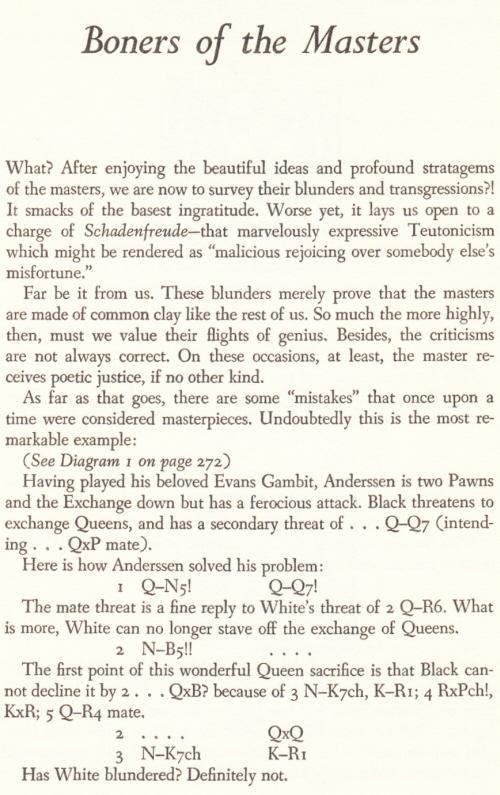
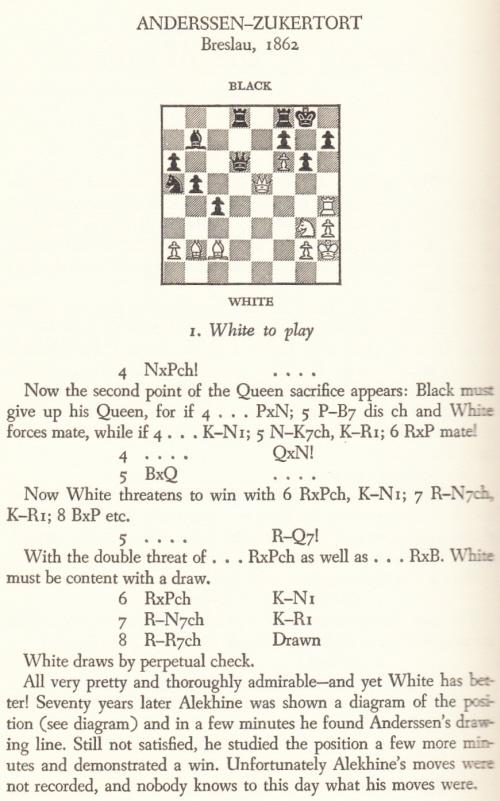
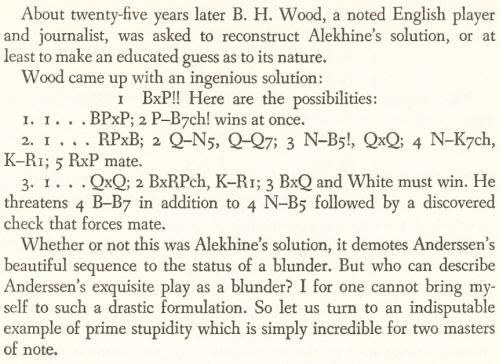


Reinfeld stated in The Joys of Chess that the game was an Evans Gambit, but we have yet to trace the full score.

Adolf Anderssen
The above article originally appeared in 2012 at ChessBase.com.
Carl Rundqvist (Stockholm) comments on this position in the game Anderssen v Zukertort, Breslau, 1862:
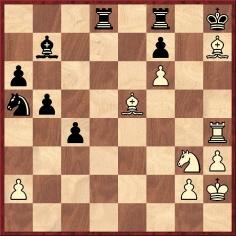
Black to move
In analysis without sight of the board Alekhine remarked that 1...Rfe8 was the only move permitting Black to prolong resistance. An alternative line given was 1...Rd2 2 Be4+ Kg8 3 Nf5, etc.
The critical move is indeed 1...Rfe8 but, for the record, Mr Rundqvist mentions the result of a computer check: 1...Rfe8 allows mate in nine moves, there is a mate in eight after 1...Rd2, and the move permitting Black to survive the longest is 1...Bc8.
(7917)
An interesting possibility deserves mention.
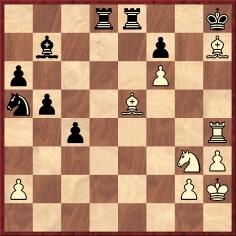
In this position (after 1 Bxg6 Qxe5 2 Bxh7+ Kh8 3 Bxe5 Rfe8) Alekhine described 4 Bc3 (‘!!’) as ‘a profound move’. However, White can leave his queen’s bishop en prise and force mate with 4 Nf5.
(7928)
Reinfeld also discussed the game ending on pages 33-35 of How to Fight Back (New York, 1955).
To the Chess Notes main page.
To the Archives for other feature articles.
Copyright: Edward Winter. All rights reserved.